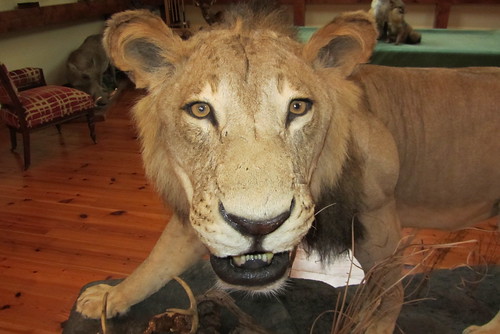歐洲法律過去一直存在漏洞,讓瀕危動物狩獵戰利品得以進入歐盟。現歐盟已修法,5日起這個漏洞將不復存在,野生動物保育人士同表欣慰。
戰利品規範有漏洞 跨國盜獵犯罪難禁
獅、北極熊、象和犀牛的狩獵戰利品貿易,一直以來存在疑慮。
歐盟環境、海洋與漁業執委會委員Karmenu Vella of Malta指出,犯罪集團涉入越來越深,野生動物走私演變成如人口販賣、毒品和軍火的跨國組織犯罪。
過去,28個歐盟會員國沒有科學權威組成的系統性檢查機構,針對進入歐盟的6物種狩獵戰利品,審核其來源是否為永續狩獵。因此,犯罪集團利用此漏洞把犀牛角當做狩獵戰利品進口歐洲,接著出口到越南。
歐盟修法 確保狩獵市場永續
根據新法,6種物種的狩獵戰利品進入歐盟必須先獲得歐盟國許可,包括非洲獅、北極熊、非洲象、南部白犀牛、河馬和盤羊,目的在確保狩獵戰利品來源的合法性和永續性。
Vella表示,歐盟只有在有證據證明進口品符合永續條件時才能核發許可。如未達條件,則禁止進口。
新法將禁止來自西非多國的獅子狩獵戰利品,這些國家大多有非永續狩獵的問題,包括貝南、布吉納法索,也可能包括喀麥隆。
去年一整年的調查顯示,西非獅子數量嚴重減少,野外只剩下約400頭。2008到2012年間,1438件獅子狩獵戰利品進入歐盟,其中超過1040件來自南非,這裡大部分被狩獵的獅子是圈養的。
然而,有395件來自非洲其他地區,而非洲其他地區的狩獵活動是獵殺野生獅。其中63件是西非的瀕危亞種,跟其他非洲獅不同種,有80%的戰利品進入法國。
科學方法打分數 「負評」國家不能進歐洲市場
根據華盛頓公約,非洲獅是保育物種,貿易非洲獅製品受到嚴格控管。不過依華盛頓公約,狩獵戰利品屬於家庭私人物品,不受貿易規範限制。
 野生動物製品進口歐盟由《歐盟野生動植物貿易規範》管轄,《歐盟野生動植物貿易規範》是實踐華盛頓公約內涵的歐盟法律。
野生動物製品進口歐盟由《歐盟野生動植物貿易規範》管轄,《歐盟野生動植物貿易規範》是實踐華盛頓公約內涵的歐盟法律。
如有需要更進一步確保野生動物貿易的永續性,歐盟也可以採取更嚴苛、超越華盛頓公約的規範限制貿易。
歐盟科學審查小組負責針對野生動植物製品進口是否會影響物種保育給予歐盟建議。歐盟執委會去年提案,欲暫停從歐盟科學審查小組給「負評」的國家進口6大物種狩獵戰利品。被給負評的國家有貝南、布吉納法索和喀麥隆。
歐盟各國政府和歐洲議會去年皆核准這個提案。提案已於2月5日生效。
獅子援助組織現在進一步呼籲,全面禁止從准許戰利品狩獵的非洲國家進口獅子戰利品,包括科學審核小組給予「正評」的國家──坦尚尼亞、納米比亞和南非。
A loophole in European law that has allowed body parts from endangered animals to be imported into the European Union as hunting trophies was closed Thursday in a move welcomed by wildlife conservationists.
The new measure introduces the requirement that import permits must be issued by EU Member States for hunting trophies of six species – African lion, polar bear, African elephant, Southern white rhinoceros, hippopotamus and argali sheep.
The measure is intended to guarantee that the origin of any imported hunting trophy is legal and sustainable.
There has been great concern about the trade in hunting trophies from lions, polar bears, elephants and rhinoceroses. Criminal groups are increasingly involved, and wildlife trafficking has become a form of transnational organized crime that resembles trafficking in human beings, drugs and firearms, says European Commissioner for Environment, Maritime and Fisheries Karmenu Vella of Malta.
In the past, there was no systematic scrutiny by scientific authorities in the 28 EU Member States to ensure that trophies from these six species imported to the European Union were the result of sustainable hunting. As a result, the system was abused by criminal gangs to import rhino horns as hunting trophies, which were then fraudulently exported to Vietnam.
Vella says permits will only be delivered once the EU is convinced that the intended trophy import meets criteria demonstrating that it is sustainable. If the criteria are not met, the import will be banned.
The new rules will ban imports of lion hunting trophies into the EU from a number of West African countries where there is concern that lions are not being hunted sustainably, including Benin, Burkina Faso and potentially Cameroon.
A survey last year found there has been a “catastrophic collapse” in the number of lions in West Africa, with only around 400 left in the wild.
Between 2008 and 2012, 1,438 lion hunting trophies were imported into the EU. More than 1,040 of these came from South Africa, where the vast majority of hunted lions are bred in captivity.
However, 395 of the hunting trophies came from other African countries where lions are shot in the wild. These include 63 from highly endangered populations in West Africa, a sub-species distinct from other African lions, 80 percent of which were imported to France.
Under the Convention on International Trade in Endangered Species, CITES, the global treaty which regulates the international trade in wild animals, African lions are designated as a protected species, meaning trade in their body parts is strictly regulated.
But under CITES rules hunting trophies are considered as “household and personal effects,” so they receive a derogation which exempts them from trade regulations.
Imports of wildlife products into the EU are governed by the EU Wildlife Trade Regulation, which implements the provisions of CITES into EU law. However, the EU can also impose stricter regulations that go beyond CITES requirements where necessary to ensure trade in wild animals is truly sustainable.
Last year, the European Commission proposed to suspend imports of hunting trophies of lions and the five other species from countries that have received a “negative opinion” from the EU’s Scientific Review Group, which gives advice on whether wildlife imports will have a harmful effect on species conservation.
These countries include Benin, Burkina Faso and Cameroon.
The proposal was approved by EU national governments and the European Parliament last year and took effect on February 5.
LionAid is now calling for a total ban on all lion trophy imports from African countries that allow trophy hunting of lions. These include those which currently enjoy a “positive opinion” in terms of lion trophy imports – Tanzania, Namibia and South Africa.
※ 全文及圖片詳見:ENS









